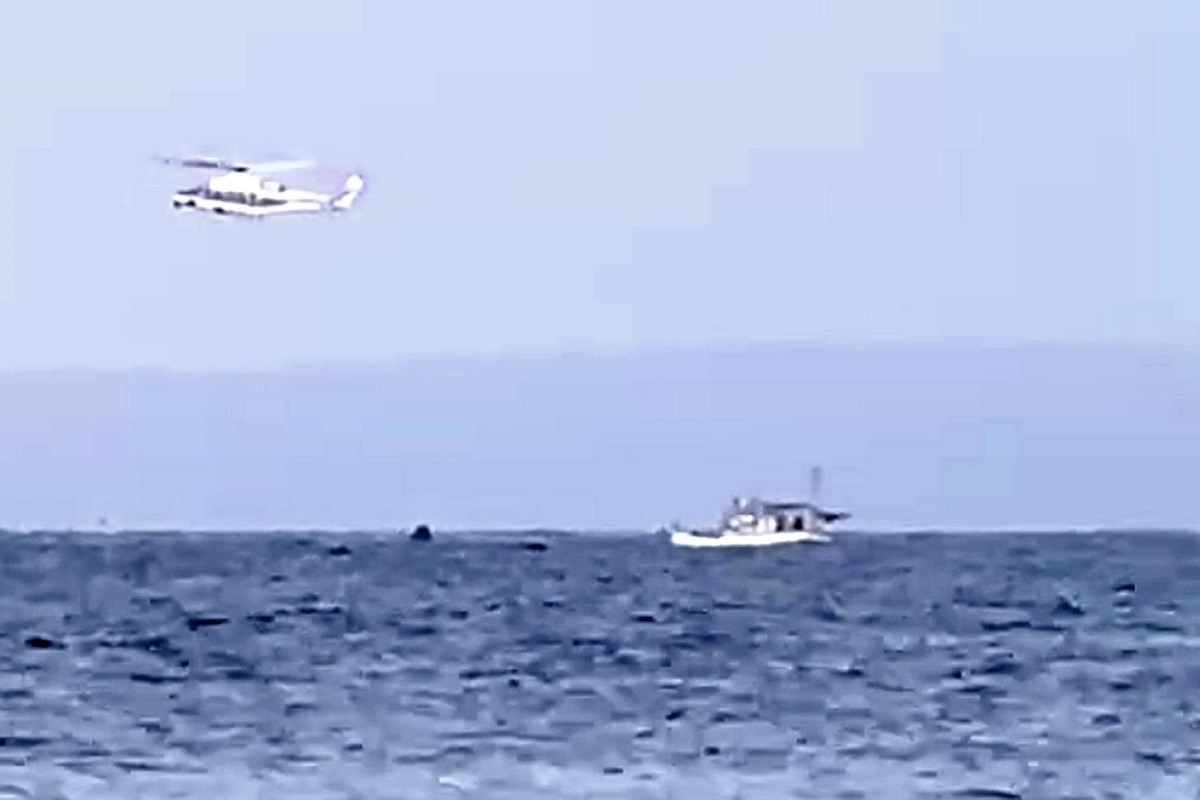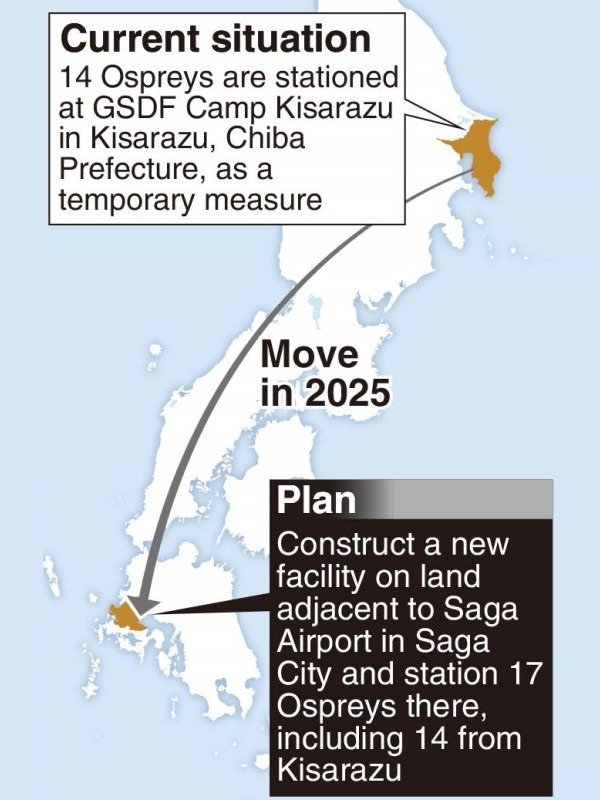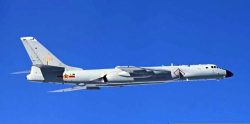Japan Government Fears Osprey Crash May Hinder Deployment; Aircraft Essential for Defense of Nansei Islands

A helicopter and a fishing boat are seen off Yakushima Island, Kagoshima Prefecture, after a U.S. military Osprey aircraft crashed in the area Wednesday.
7:00 JST, December 1, 2023
The crash of a U.S. military Osprey aircraft Wednesday has stoked government fears that public sentiment could sour over the planned deployment of 17 Japanese Ospreys to Saga Prefecture, and raised concerns about the possible impact on the nation’s security.
The accident in waters off Yakushima Island, Kagoshima Prefecture, occurred just as preparations had finally kicked into high gear for the new facility where the Ground Self-Defense Force’s Ospreys would be stationed. The government intends to broaden support among local authorities in Saga for the Osprey’s deployment through such steps as pinpointing the accident’s cause, and to steadily push ahead with the transfer of the tilt-rotor transport aircraft, which will be essential for the defense of the Nansei Islands.

Planned deployment of GSDF’s Osprey transport aircraft
Prime Minister Fumio Kishida refused to say whether the GSDF would suspend operation of its Ospreys following the crash.
“We need to confirm the facts of the accident, and then we should consider what steps must be taken,” Kishida said to reporters at the Prime Minister’s Office on Wednesday evening.
The GSDF operates 14 Ospreys that are currently stationed at GSDF Camp Kisarazu in Chiba Prefecture. The government is moving ahead with a plan to deploy a total of 17 Ospreys, including the 14 from the Kisarazu base, at a new facility being constructed on land adjacent to Saga Airport in Saga City.
Transfer of the aircraft to the new facility is scheduled to be completed by July 2025.
Since deciding to procure Ospreys in 2013, the government has faced roadblock after roadblock when trying to select a location at which to station them. In July 2014, the Defense Ministry sounded out the Saga prefectural government about operating the aircraft out of Saga Airport, but talks with a local fishery cooperative became bogged down over concerns about the possible impact on the fishing industry.
The government decided to station the Ospreys at the Kisarazu base from July 2020 as a temporary measure.
The cooperative eventually gave its approval to the deployment plan in November 2022, and construction of the new facility near Saga Airport started in June this year.
The Osprey that crashed Wednesday was a CV-22 model, which is used to conduct missions for U.S. special operations forces. Although the GSDF’s V-22 Ospreys are used primarily as transport aircraft, the airframe structure and basic functions are said to be the same.
“This accident happened at a stage when local support for the deployment had finally started to solidify,” a government official said. “The timing is not good.”
Training axed
The GSDF had invited officials from nearby local governments to a display of an Osprey at GSDF Camp Metabaru in Yoshinogari, Saga Prefecture, on Wednesday. The aircraft was also scheduled to conduct a training flight Thursday, but that was canceled following Wednesday’s accident.
“Danger constantly lurks in these aircraft,” one Saga city assembly member who inspected the aircraft said.
Saga Gov. Yoshinori Yamaguchi called on the Defense Ministry to swiftly provide information on the accident. “I have a strong interest in finding out what happened,” Yamaguchi said to reporters at the prefectural government office Wednesday evening.
After a U.S. military Osprey crashed off Australia’s east coast in 2017, the Japanese government asked the U.S. side to refrain from flying the aircraft in Japan for some time. The government made a similar request to the U.S. government following the latest accident.
The government appears to be taking this step in a bid to prevent local sentiment from significantly worsening due to the crash, as any additional delays in deploying the Ospreys to Saga Airport could have a detrimental effect on Japan’s national security.
Essential aircraft
Ospreys can take off and land vertically, so they do not need a long runway. In addition, they are capable of flying long distances at fast speeds. The U.S. Marine Corps’ MV-22 – which the GSDF also operates – had an average of 2.27 serious accidents per 100,000 flight hours, as of the end of September 2022. This figure is lower than the 2.59 serious accidents reported overall for all aircraft operated by the Marine Corps.
Given the Ospreys’ excellent performance and safety, the United States actively uses the aircraft for transporting key officials and in operations on the front line, among other missions.
As China steps up its hegemonic moves in the region, the Osprey deployment will be critical for transporting Japanese personnel and other missions in the event of a contingency.
“Defense of the Nansei Islands is an urgent task,” a senior Defense Ministry official told The Yomiuri Shimbun. “The government needs to carefully explain the situation to local authorities and people to ensure the deployment plan progresses as scheduled.”
"Politics" POPULAR ARTICLE
-

Japan to Support Central Asian Logistics Route That Bypasses Russia, Plan to Be Part of Upcoming Summit in Tokyo
-

Japan to Tighten Screening of Foreigners’ Residential Status by Providing Information of Nonpayment of Taxes
-

Chinese, Russian Bombers Flew Unusual Path by Heading Toward Tokyo; Move Likely Meant to Intimidate Japan
-

Japan Plans National Database to Track Foreign Ownership of Real Estate, Land as It Weighs New Rules
-

Up to 199,000 Deaths Estimated From Mega-Tsunami; Most Recent Occurrence Took Place in 17th Century
JN ACCESS RANKING
-

Keidanren Chairman Yoshinobu Tsutsui Visits Kashiwazaki-Kariwa Nuclear Power Plant; Inspects New Emergency Safety System
-

Tokyo Economic Security Forum to Hold Inaugural Meeting Amid Tense Global Environment
-

Imports of Rare Earths from China Facing Delays, May Be Caused by Deterioration of Japan-China Relations
-

University of Tokyo Professor Discusses Japanese Economic Security in Interview Ahead of Forum
-

Japan Pulls out of Vietnam Nuclear Project, Complicating Hanoi’s Power Plans
























